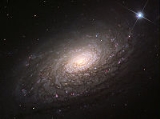
Sunflower Galaxy
Encyclopedia
The Sunflower Galaxy is a spiral galaxy
in the constellation
Canes Venatici
consisting of a central disc surrounded by many short spiral arm segments. The Sunflower Galaxy is part of the M51 Group
, a group of galaxies that also includes the Whirlpool Galaxy (M51)
.
on June 14, 1779. The galaxy was then listed by Charles Messier
as object 63 in the Messier Catalogue.
In the mid-19th century, Lord Rosse identified spiral structure within the galaxy, making this one of the first galaxies in which such structure was identified.
In 1971, a supernova with a magnitude of 11.8 appeared in one of the arms of M63.
Spiral galaxy
A spiral galaxy is a certain kind of galaxy originally described by Edwin Hubble in his 1936 work The Realm of the Nebulae and, as such, forms part of the Hubble sequence. Spiral galaxies consist of a flat, rotating disk containing stars, gas and dust, and a central concentration of stars known as...
in the constellation
Constellation
In modern astronomy, a constellation is an internationally defined area of the celestial sphere. These areas are grouped around asterisms, patterns formed by prominent stars within apparent proximity to one another on Earth's night sky....
Canes Venatici
Canes Venatici
Canes Venatici is one of the 88 official modern constellations. It is a small northern constellation that was created by Johannes Hevelius in the 17th century. Its name is Latin for "hunting dogs", and the constellation is often depicted in illustrations as representing the dogs of Boötes the...
consisting of a central disc surrounded by many short spiral arm segments. The Sunflower Galaxy is part of the M51 Group
M51 Group
The M51 Group is a group of galaxies located in Canes Venatici. The group is named after the brightest galaxy in the group, the Whirlpool Galaxy...
, a group of galaxies that also includes the Whirlpool Galaxy (M51)
Whirlpool Galaxy
The Whirlpool Galaxy is an interacting grand-design spiral galaxy that is estimated to be 23 ± 4 million light-years from the Milky Way Galaxy. in the constellation Canes Venatici...
.
History
The Sunflower Galaxy was discovered by Pierre MéchainPierre Méchain
Pierre François André Méchain was a French astronomer and surveyor who, with Charles Messier, was a major contributor to the early study of deep sky objects and comets.-Life:...
on June 14, 1779. The galaxy was then listed by Charles Messier
Charles Messier
Charles Messier was a French astronomer most notable for publishing an astronomical catalogue consisting of deep sky objects such as nebulae and star clusters that came to be known as the 110 "Messier objects"...
as object 63 in the Messier Catalogue.
In the mid-19th century, Lord Rosse identified spiral structure within the galaxy, making this one of the first galaxies in which such structure was identified.
In 1971, a supernova with a magnitude of 11.8 appeared in one of the arms of M63.

